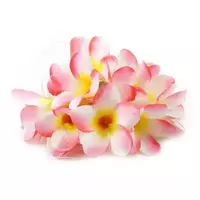Plumeria (frangipani)

Surely lovers of perfumes, as well as culinary connoisseurs, know the word frangipani. First of all, it is customary to mean a tropical flowering tree or plumeria, which belongs to the family Apocalypyneae. In addition, frangipani or frangipan means a special confectionery cream, which is a kind of nut mass made from ground almonds, powdered sugar or granulated sugar, eggs, butter, rum and natural vanilla.
However, I would like to turn to the first name, that is, the plant of plumeria (frangipani). This genus, as you know, has about ten species. At the same time, the common name plumeria (frangipani) owes to an Italian nobleman who invented perfume using the amazing aroma of this plant.
In general, plumeria (frangipani) is widespread in the tropical zones of the Pacific islands, in the Caribbean, in Mexico, South America and California. Under the condition of a mild climate, the plant can be cultivated in the open ground, while in the cool it is grown in containers, since plumeria (frangipani) is especially sensitive to cold.
Of interest to humans are plumeria (frangipani) flowers, which exude a flavor reminiscent of a mixture of citrus, jasmine, gardenia and spices. The flowers of the plant have five petals, although sometimes you can find specimens with 4, 6, 7 petals. Plumeria (frangipani) petals are mostly oval-shaped, with much less commonly observed in the shape of a scapula. In addition, they can be narrow, wide, twisted or flat.
Most flowers of plumeria (frangipani) are distinguished by a subtle pleasant smell, which is most intense in the morning. It is almost impossible to describe this aroma, since it is able to change depending on the surrounding conditions.
Plumeria (Frangipani) is considered the national flower of Laos and Bali. Even in the ancient Maya, it was a symbol of love, and, interestingly, it was its erotic manifestation, symbolizing lust. In some Buddhist countries, plumeria (frangipani) is still a symbol of immortality, therefore, it is often planted on the territory and around temples, while calling it a temple plant.
Plumeria (frangipani) is widely used in both cosmetology and cooking. For example, her attractive delicate flowers in fresh form can decorate confectionery, acting as decor. In addition, extracts from plumeria oil (frangipani) are characterized by an anti-inflammatory, antioxidant and regenerating effect on the human skin, which causes the use of this plant in body care products.
plumeria (frangipani) 0 kCal
Energy value of plumeria (frangipani) (Ratio of proteins, fats, carbohydrates - ju):
Proteins: 0 g (~ 0 kCal)
Fats: 0 g (~ 0 kCal)
Carbohydrates: 0 g (~ 0 kCal)
 Español
Español Français
Français Português
Português Русский
Русский 简体中文
简体中文 繁體中文
繁體中文 日本語
日本語 한국어
한국어 العربية
العربية Türkçe
Türkçe Қазақ
Қазақ Deutsch
Deutsch Italiano
Italiano Українська
Українська
